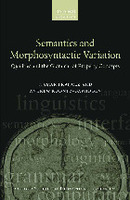Semantics and Morphosyntactic Variation: Qualities and the Grammar of Property Concepts
| dc.contributor.author | Francez, Itamar | |
| dc.contributor.author | Koontz-Garboden, Andrew | |
| dc.date.accessioned | 2017-03-01 23:55:55 | |
| dc.date.accessioned | 2018-10-03 09:09:28 | |
| dc.date.accessioned | 2020-04-01T13:35:38Z | |
| dc.date.available | 2020-04-01T13:35:38Z | |
| dc.date.issued | 2017 | |
| dc.identifier | 628110 | |
| dc.identifier | OCN: 976434207 | en_US |
| dc.identifier.uri | http://library.oapen.org/handle/20.500.12657/31448 | |
| dc.description.abstract | Systematic variation in form between semantic equivalents across languages is a key explanandum of linguistic theory. Two contrasting views of the role of lexical semantics in the analysis of such variation can be found in the literature: (1) uniformity, whereby lexical meaning is universal, and morphosyntactic variation arises from idiosyncratic differences in the inventory and phonological shape of language-particular functional material, and (2) transparency, whereby systematic variation in form arises from systematic variation in the meaning of basic lexical items. This volume contrasts these views as applied to the empirical domain of property concept sentences—sentences expressing adjectival predication and their translational equivalents across languages. Demonstrating that property concept sentences vary systematically between possessive and predicative form, the authors propose a transparentist analysis of this variation that links it to the lexical denotations of basic property concept lexemes. At the heart of the analysis are qualities: mass-like model-theoretic objects that closely resemble scales. The authors contrast their transparentist analysis with uniformitarian alternatives, demonstrating its theoretical and empirical advantages. They then show that the proposed theory of qualities can account for interesting and novel observations in two central domains of grammatical theory: the theory of lexical categories, and the theory of mass nouns. The overall results highlight the importance of the lexicon as a locus of generalizations about the limits of crosslinguistic variation. | |
| dc.language | English | |
| dc.relation.ispartofseries | Oxford Studies in Theoretical Linguistics | |
| dc.subject.classification | thema EDItEUR::C Language and Linguistics::CF Linguistics::CFG Semantics, discourse analysis, stylistics | en_US |
| dc.subject.classification | thema EDItEUR::C Language and Linguistics::CF Linguistics::CFK Grammar, syntax and morphology | en_US |
| dc.subject.other | morphosyntactic variation | |
| dc.subject.other | property concepts | |
| dc.subject.other | lexical semantics | |
| dc.subject.other | lexical categories | |
| dc.subject.other | qualities | |
| dc.subject.other | mass nouns | |
| dc.subject.other | adjectives | |
| dc.subject.other | semantic variation | |
| dc.subject.other | Denotation | |
| dc.subject.other | Lexeme | |
| dc.subject.other | Part of speech | |
| dc.subject.other | Predicate (grammar) | |
| dc.subject.other | Syntax | |
| dc.title | Semantics and Morphosyntactic Variation: Qualities and the Grammar of Property Concepts | |
| dc.type | book | |
| oapen.identifier.doi | 10.1093/acprof:oso/9780198744580.001.0001 | |
| oapen.relation.isPublishedBy | b9501915-cdee-4f2a-8030-9c0b187854b2 | |
| oapen.relation.isFundedBy | 08ee9d08-628f-4db8-aea8-9a2c0dbb3420 | |
| oapen.relation.isbn | 9780198744580 | |
| oapen.pages | 192 | |
| oapen.place.publication | Oxford, UK | |
| oapen.remark.public | Relevant Wikipedia pages: Adjective - https://en.wikipedia.org/wiki/Adjective; Denotation - https://en.wikipedia.org/wiki/Denotation; Lexeme - https://en.wikipedia.org/wiki/Lexeme; Lexical semantics - https://en.wikipedia.org/wiki/Lexical_semantics; Mass noun - https://en.wikipedia.org/wiki/Mass_noun; Morphology (linguistics) - https://en.wikipedia.org/wiki/Morphology_(linguistics); Part of speech - https://en.wikipedia.org/wiki/Part_of_speech; Predicate (grammar) - https://en.wikipedia.org/wiki/Predicate_(grammar); Semantics - https://en.wikipedia.org/wiki/Semantics; Syntax - https://en.wikipedia.org/wiki/Syntax | |
| oapen.identifier.ocn | 976434207 |

